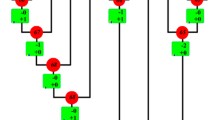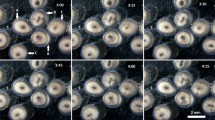Abstract
The formation of the allotetraploid hybrid lineage (4nAT) encompasses both distant hybridization and polyploidization processes. The allotetraploid offspring have two sets of sub-genomes inherited from both parental species, and therefore, it is important to explore its genetic structure. Herein, we construct a bacterial artificial chromosome library of allotetraploids, and then sequence and analyze the full-length sequences of 19 bacterial artificial chromosomes. Sixty-eight DNA chimeras are identified, which are divided into four models according to the distribution of the genomic DNA derived from the parents. Among the 68 genetic chimeras, 44 (64.71%) are linked to tandem repeats (TRs) and 23 (33.82%) are linked to transposable elements (TEs). The chimeras linked to TRs are related to slipped-strand mispairing and double-strand break repair while the chimeras linked to TEs benefit from the intervention of recombinases. In addition, TRs and TEs can also result in insertions/deletions of DNA segments. We conclude that DNA chimeras accompanied by TRs and TEs coordinate a balance between the sub-genomes derived from the parents. It is the first report on the relationship between formation of the DNA chimeras and TRs and TEs in the polyploid animals.






Similar content being viewed by others
References
Anderson LK, Hooker KD, Stack SM (2001) The distribution of early recombination nodules on zygotene bivalents from plants. Genetics 159:1259–1269
Belancio VP, Roy-Engel AM, Deininger PL (2010) All y’all need to know ‘bout retroelements in cancer. Semin Cancer Biol 20:200–210
Bennetzen JL (2000) Transposable element contributions to plant gene and genome evolution. Plant Mol Biol 42:251–269
Bennetzen JL (2005) Transposable elements, gene creation and genome rearrangement in flowering plants. Curr Opin Genet Dev 15:621–627
Bichara M, Wagner J, Lambert IB (2006) Mechanisms of tandem repeat instability in bacteria. Mutat Res Fundam Mol Mech Mutagen 598:144–163
Blair MW, Torres MM, Giraldo MC, Pedraza F (2009) Development and diversity of Andean-derived, gene-based microsatellites for common bean (Phaseolus vulgaris L.) BMC Plant Biol 9:100
Bruggmann R, Bharti AK, Gundlach H, Lai J, Young S et al (2006) Uneven chromosome contraction and expansion in the maize genome. Genome Res 16:1241–1251
Catasti P, Chen X, Mariappan SVS, Bradbury EM, Gupta G (1999) DNA repeats in the human genome. Genetica 106:15–36
Christiansen G, Molitor C, Philmus B, Kurmayer R (2008) Nontoxic strains of cyanobacteria are the result of major gene deletion events induced by a transposable element. Mol Biol Evol 25:1695–1704
Cox R, Mirkin SM (1997) Characteristic enrichment of DNA repeats in different genomes. Proc Natl Acad Sci U S A 94:5237–5242
Cridland JM, Macdonald SJ, Long AD, Thornton KR (2013) Abundance and distribution of transposable elements in two Drosophila QTL mapping resources. Mol Biol Evol 30:2311–2327
Debrauwere H, Gendrel CG, Lechat S, Dutreix M (1997) Differences and similarities between various tandem repeat sequences: minisatellites and microsatellites. Biochimie 79:577–586
Du RQ (2003) Biostatistics (in Chinese), 2nd edn. Higher Education Press, Beijing, pp 80–81
Echenique VC, Stamova B, Wolters P, Lazo G, Carollo V et al (2002) Frequencies of Ty1-copia and Ty3-gypsy retroelements within the Triticeae EST databases. Theor Appl Genet 104:840–844
Finnegan DJ (1992) Transposable elements. Curr Opin Genet Dev 2(6):153–184
Gaeta RT, Chris PJ (2010) Homoeologous recombination in allopolyploids: the polyploid ratchet. New Phytol 186:18–28
Gemayel R, Vinces MD, Legendre M, Verstrepen KJ (2010) Variable tandem repeats accelerate evolution of coding and regulatory sequences. Annu Rev Genet 44:445–477
Goodwin TJ, Butler MI, Poulter RT (2003) Cryptons: a group of tyrosine-recombinase-encoding DNA transposons from pathogenic fungi. Microbiology 149:3099–3109
Heyer WD, Ehmsen KT, Jie L (2010) Regulation of homologous recombination in eukaryotes. Annu Rev Genet 44:113–139
Jelesko JG, Carter K, Thompson W, Kinoshita Y, Gruissem W (2004) Meiotic recombination between paralogous RBCSB genes on sister chromatids of Arabidopsis thaliana. Genetics 166:947–957
Jiang N, Bao Z, Zhang X, Wessler SR (2004) Pack-MULE transposable elements mediate gene evolution in plants. Nature 431:569–573
Kapitonov VV, Jurka J (2006) Self-synthesizing DNA transposons in eukaryotes. Proc Natl Acad Sci U S A 103:4540–4545
Katti MV, Ranjekar PK, Gupta VS (2001) Differential distribution of simple sequence repeats in eukaryotic genome sequences. Mol Biol Evol 18:1161–1167
Kazazian HH (2004) Mobile elements: drivers of genome evolution. Science 303:1626–1632
Kunze R, Saedler H, Lonnig WE (1997) Plant transposable elements. Adv Bot Res 27:331–470
Levinson G, Gutman GA (1987) Slipped-strand mispairing: a major mechanism for DNA sequence evolution. Mol Biol Evol 4:203–221
Li L, Jean M, Belzile F (2006) The impact of sequence divergence and DNA mismatch repair on homeologous recombination in Arabidopsis. Plant J 45:908–916
Lim KY, Kovarik A, Matyasek R, Mark W, Chase MW, James JC et al (2007) Sequence of events leading to near-complete genome turnover in allopolyploid Nicotiana within five million years. New Phytol 175:756–763
Linardopoulou EV, Williams EM, Fan Y, Friedman C, Young JM et al (2005) Human subtelomeres are hot spots of interchromosomal recombination and segmental duplication. Nature 437:94–100
Liu B, Wendel JF (2002) Non-Mendelian phenomena in allopolyploid genome evolution. Curr Genomics 3:489–505
Liu S, Liu Y, Zhou G, Zhang X, Luo C et al (2001) The formation of tetraploid stocks of red crucian carp × common carp hybrids as an effect of interspecific hybridization. Aquaculture 192:171–186
Liu S, Luo J, Chai J, Ren L, Zhou Y et al (2016) Genomic incompatibilities in the diploid and tetraploid offspring of the goldfish × common carp cross. Proc Natl Acad Sci U S A 113:1327–1332
Masterson J (1994) Stomatal size in fossil plants: evidence for polyploidy in majority of angiosperms. Science 264:421–424
Mezard C, Vignard J, Drouaud J, Mercier R (2007) The road to crossovers: plants have their say. Trends Genet 23:91–99
Naranjo T, Corredor E (2008) Nuclear architecture and chromosome dynamics in the search of the pairing partner in meiosis in plants. Cytogenet Genome Res 120:320–330
Oliver KR, Greene WK (2009) Transposable elements: powerful facilitators of evolution. Genes Genomes 31:703–714
Pontes O, Neves N, Silva M, Lewis MS, Madlung A et al (2004) Chromosomal locus rearrangements are a rapid response to formation of the allotetraploid Arabidopsis suecica genome. Proc Natl Acad Sci U S A 101:18240–18245
Qi L, Friebe B, Zhang P, Gill BS (2007) Homoeologous recombination, chromosome engineering and crop improvement. Chromosom Res 15:3–19
Rizzon C, Marais G, Gouy M, Biémont C (2002) Recombination rate and the distribution of transposable elements in the Drosophila melanogaster genome. Genome Res 12:400–407
Salmon A, Flagel L, Ying B, Udall JA, Wendel JF (2010) Homoeologous nonreciprocal recombination in polyploid cotton. New Phytol 186(1):123–134
San FJ, Sung P, Klein H (2008) Mechanism of eukaryotic homologous recombination. Annu Rev Biochem 77:229–257
Sang T, Crawford DJ, Stuessy TF (1995) Documentation of reticulate evolution in peonies (Paeonia) using internal transcribed spacer sequences of nuclear ribosomal DNA: implications for biogeography and concerted evolution. Proc Natl Acad Sci U S A 92:6813–6817
Sanmiguel P, Bennetzen JL (1998) Evidence that a recent increase in maize genome size was caused by the massive amplification of intergene retrotransposons. Ann Bot 82:37–44
Schug MD, Hutter CM, Wetterstrand KA, Gaudette MS, Mackay TF et al (1998) The mutation rates of di-, tri- and tetranucleotide repeats in Drosophila melanogaster. J Neurosci Res 15:1751–1760
Shapiro JA (2005) A 21st century view of evolution: genome system architecture, repetitive DNA, and natural genetic engineering. Gene 345:91–100
Shapiro JA, Sternberg RV (2005) Why repetitive DNA is essential to genome function. Biol Rev 80:227–250
Sharma A, Wolfgruber TK, Presting GG (2013) Tandem repeats derived from centromeric retrotransposons. BMC Genomics 14:1–11
Song C, Liu S, Xiao J, He WG, Zhou Y et al (2012) Polyploid organisms. Sci China Life Sci 55:301–311
Stults DM, Killen MW, Williamson EP, Hourigan JS, Vargas HD et al (2009) Human rRNA gene clusters are recombinational hotspots in cancer. Cancer Res 69:9096–9104
Szostak JW, Orr-Weaver TL, Rothstein RJ, Stahl FW (1983) The double-strand-break repair model for recombination. Cell Sci 33:25–35
Toth G, Gaspari ZJ (2002) Microsatellites in different eukaryotic genomes: survey and analysis. Sociol Rural 46:40–60
Udall JA, Quijada PA, Osborn TC (2005) Detection of chromosomal rearrangements derived from homeologous recombination in four mapping populations of Brassica napus L. Genetics 169:967–979
Verstrepen KJ, An J, Lewitter F, Fink GR (2005) Intragenic tandem repeats generate functional variability. Nat Genet 37(9):986
Wang J, Ye LH, Liu QZ, Peng LY, Liu W et al (2015) Rapid genomic DNA changes in allotetraploid fish hybrids. Heredity 114:601–609
Wendel JF (2000) Genome evolution in polyploids. Plant Mol Biol 42:225–249
Wendel JF, Schnabel T, Seelanan T (1995) Bidirectional interlocus concerted evolution following allopolyploid speciation in cotton (Gossypium). Proc Natl Acad Sci U S A 92(1):280–284
White SE, Wessler SR (1994) Retrotransposons in the flanking regions of normal plant genes: a role for copia-like elements in the evolution of gene structure and expression. Proc Natl Acad Sci U S A 91:11792–11796
Yang S, Arguello JR, Li X, Ding Y, Zhou Q et al (2008) Repetitive element-mediated recombination as a mechanism for new gene origination in, Drosophila. PLoS Genet 4:63–71
Zwierzykowski Z, Tayyar R, Brunell M, Lukaszewski AJ (1998) Genome recombination in intergeneric hybrids between tetraploid Festuca pratensis and Lolium multiflorum. J Hered 89:324–328
Acknowledgments
This work was supported by the National Natural Science Foundation of China (grants 30930071, 91331105, 31360514, 31430088, and 31210103918), the Cooperative Innovation Center of Engineering and New Products for Developmental Biology of Hunan Province (20134486), the Construction Project of Key Discipline of Hunan Province and China, and the National High Technology Research and Development Program of China (Grant No. 2011AA100403).
Author information
Authors and Affiliations
Corresponding author
Ethics declarations
Conflict of Interest
The authors declare that they have no conflict of interest.
Electronic Supplementary Material
ESM 1
(DOCX 4133 kb)
Rights and permissions
About this article
Cite this article
Ye, L., Jiao, N., Tang, X. et al. Chimeras Linked to Tandem Repeats and Transposable Elements in Tetraploid Hybrid Fish. Mar Biotechnol 19, 401–409 (2017). https://doi.org/10.1007/s10126-017-9764-6
Received:
Accepted:
Published:
Issue Date:
DOI: https://doi.org/10.1007/s10126-017-9764-6




